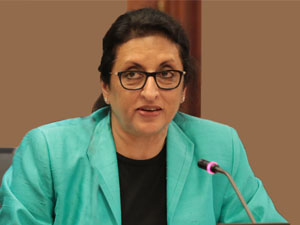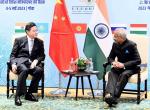Shinzo Abe’s decisive victory in the mid term polls on December 14 augurs well for the future of India-Japan relations. Diplomatic ties between India and Japan that have seen an upswing over the past two decades are slated to assume even greater significance in the coming years. While Prime Minister Mori and Prime Minister Vajpayee laid the foundations for a robust partnership between India and Japan, many factors have contributed to this, the main being the changing strategic balance of power in Asia-Pacific due to China’s rise and domestic economic challenges that have bound both India and Japan to examine ways of fostering economic interdependence through bilateral and multilateral trade security agreements.
Japan has steadily come to occupy an extremely significant place in India's foreign policy and economic calculus and is one of the main pillars of India's Look East Policy. The great bonhomie between Prime Minister Modi and Prime Minister Abe is well known and Japan was the first bilateral visit by Modi outside India’s immediate neighbourhood. Modi and Abe, through their chemistry have been able to establish a new era in relations between both countries. Critical areas where the interests of the two countries converge include the economy, education, science and technology, maritime security, proliferation of nuclear weapons, cyber security and space cooperation.
In their Joint Statement1 in September, the two Prime Ministers pledged to “realize the full potential of India - Japan Strategic and Global Partnership for continuing progress and prosperity for their people and for advancing peace, stability and prosperity in Asia and the world. Elevating the relationship to a Special Strategic and Global Partnership, they called their meeting the dawn of a new era in India - Japan relations.”
The Fact Sheet titled India and Japan - Partners for Common Development, 2 on economic initiatives between India and Japan, enumerated a number of proposals to be carried forward between the two countries. But, given the security architecture in the Asia, defence and security matters received more attention. Defence cooperation between India and Japan is strong and the trilateral Japan-India-US Malabar exercises and the Okinawa exercises between India, Japan and the US along with Singapore and Australia are progressing well.
In particular, the recent developments in Japan’s policy on transfer of defence equipment and technology are a positive outcome. This fits in with India’s own “Make in India” policy announced by Modi. There is a lot that can be done by identifying specific areas for joint production and making relevant policy recommendations to respective Governments. India and Japan can specifically explore working together in cyber security and the maritime domain – where the Indian Navy is in need of urgent modernization and Japan has the expertise in shipbuilding. Talks are at an advanced stage amongst the Joint Working Group3 on cooperation in US-2 amphibian aircraft and its technology, and if this happens, it would mark Japan's first overseas military sale in nearly 50 years.
While the recent India-Japan bilateral discussions focused more on defence and security issues, Modi also sought increased investment from Japan which is India’s fourth largest foreign direct investor. The Indian Prime Minister invited Japanese attention to stepping up cooperation in infrastructure development in India and it is hoped the two Governments will move forward together in this critical area.
India has increasingly begun to realize the benefits of foreign investment, trade, and economic integration, and a development oriented Indian Prime Minister has taken definitive steps to not just “Look East” but “Act East” by following a more vigorous policy to improve economic and strategic relations with Southeast Asia, Japan, and even China. According to Sheila Smith, Senior Fellow at the Council on Foreign Relations, "Modi went to Tokyo with a very clear message for Japanese businesses that he was going to address the country's labyrinth of regulatory and tax complications that get in the way of foreign direct investment, which the Japanese business community has scratched their heads over for a long time."4 The challenge now is for Modi to overcome domestic bureaucratic constraints and move forward on the vision he has articulated for India’s growth.
The task is not easy and Modi now must walk the talk and implement the steps that will both revive India’s economic fortunes while “simultaneously bolstering its defences and strengthening its strategic partnerships with like minded states, thereby promoting regional stability and blocking the rise of a Sino-centric Asia….This dovetails nicely with Abe’s soft nationalism, market-oriented economics, and new Asianism, seeking close ties with Asian democracies to create a web of interlocking strategic partnerships.”5
Trade links between India and Japan grew due to common underlying facets, commonly referred to as the three “Ds” – Democracy, Demography and Demand. But a lot more needs to be done in this sphere and hopefully trade will grow further.6 For Japan and India, Asia’s second and third largest economies, a trade figure of merely $ 15.8 billion in 2013 is extremely inadequate and both have a lot of ground to cover, considering that Japan is an extremely important FDI investor in India. But in the past couple of years, owing to India’s economic slump and a policy paralysis at the political level, Japanese investments in India tapered off and Japanese firms have invested more in newer emerging markets like Vietnam and Indonesia.7
But this will change as there is a complementarity between the economic and security interests of both countries. Modi and Abe, with their respective “Modinomics” and “Abenomics”, are both equally committed to ASEAN. Like Modi, Abe also gives priority to economic issues and the Japanese economy has to show signs of revival if Abe is to succeed politically. This was the reason for the mid term elections that Abe called this month. According to all reports, while Abe has won with a clear majority, there will be pressure on him to deliver on the economic front and ensure that the country comes out of recession. A low GDP growth rate of about 2% and a decline of 0.50 percent in the third quarter of 2014 over the previous quarter is not a very comfortable situation to be in.
To tackle domestic economic challenges, Abe is likely to increase the private consumption tax on rich Japanese tax payers gradually as one of the measures to revive the economy and prove that his policy (Abenomics) is doing well. Hiking the consumption tax is needed to make sure a good and firm social security system can be created and sustained. That is why Japan implemented the first round of the consumption tax of 3 % in July 2014.8 Abe’s plan is to raise it once again next year, and take it to 10 percent by 2016 in the hope that the economic environment would be more stable with Japan no longer in a deflationary state. The ratio of job openings to job seekers reached the highest level in two years, and for the first time in 15 years, incomes also went up. But it is still a fragile situation and can spin out of control if the economy does not revive to more reasonable levels.
Another tricky element of Abe’s attempts at introducing structural reforms to lift Japan’s economy out of its “deflationary malaise” is his decision to join the US led Trans Pacific Partnership being negotiated between the United States and eleven other countries in Asia. Abe announced in March 2013 that Japan—which accounted for 14 percent, or $146 billion, of U.S. goods trade with TPP partners in 2012—would seek to participate in the TPP negotiations. This was met with wide spread opposition by various Japanese groups especially the agriculture lobby. The agriculture industry has argued that this vital sector would take a hit from foreign competition due to the removal of tariffs and other protective measures on imports that would be ruinous for the Japanese farmer. Some Japanese health-care providers have also voiced concerns that Japan's national health insurance system would be adversely affected as Japanese citizens would be compelled to buy foreign-produced pharmaceuticals and medical devices.9
Despite these domestic apprehensions, Abe is of the opinion that in the long run it would be to Japan’s advantage if it was fully integrated into an Asian multilateral trade facilitation channel. India, too, faces similar predicaments at bilateral and multilateral trade fora like the WTO and efforts by the US to get it to agree to a Bilateral Investment Treaty.
There is plenty that binds the leaders of Asia’s two most prominent democracies together. Besides their common economic objectives and goals, both India and Japan, through greater strategic cooperation, are seeking to evolve an effective yet peaceful strategy to counter an increasingly assertive China in the region. The China factor further incentivizes India and Japan to cooperate in many ways and according to Modi, “write a new chapter” in India-Japan relations, while Abe said that their bilateral ties have the “most potential in the world.” Both leaders have displayed political sagacity and a strategic vision to create a strong partnership and it is in the mutual interest of both countries to build upon this promising start.
Endnotes
- For details, see http://mea.gov.in/bilateral- documents.htm?dtl/23965/Tokyo_Declaration_for_India__Japan_Special_Strategic_and_Global_Partnership, Tokyo, September 1, 2014. Accessed on 18 December 2014.
- Available at http://pib.nic.in/newsite/PrintRelease.aspx?relid=109224, accessed on 18 December , 2014.
- Referred to in the Modi-Abe Joint Statement, see foot note 1.
- Nyshka Chandran, “There’s More to Modi-Abe Ties than China, September 2, 2014, available at http://www.cnbc.com/id/101961843#. Accessed on 18 December 2014.
- Brahma Chellaney, “Narendra Modi: India’s Shinzo Abe,” The Diplomat, May 16, 2014. Available at, http://thediplomat.com/2014/05/narendra-modi-indias-shinzo-abe/ . Accessed on December 18, 2014.
- Based on an interaction with Japanese Delegation from the JIIA, Tokyo, at the VIF, December 8,2014.
- Michael Schuman, “Why India’s Modi and Japan’s Abe Need Each Other – Badly,” TIME, September 2, 2014.
- For details, see Backgrounder of the Council on Foreign Relations, available at http://www.cfr.org/japan/abenomics-japanese-economy/p30383. Accessed on 18 December 2014.
- Ibid.
Published Date: 23rd December 2014, Image source: http://www.hindustantimes.com
(Disclaimer: The views and opinions expressed in this article are those of the author and do not necessarily reflect the official policy or position of the Vivekananda International Foundation)










Post new comment